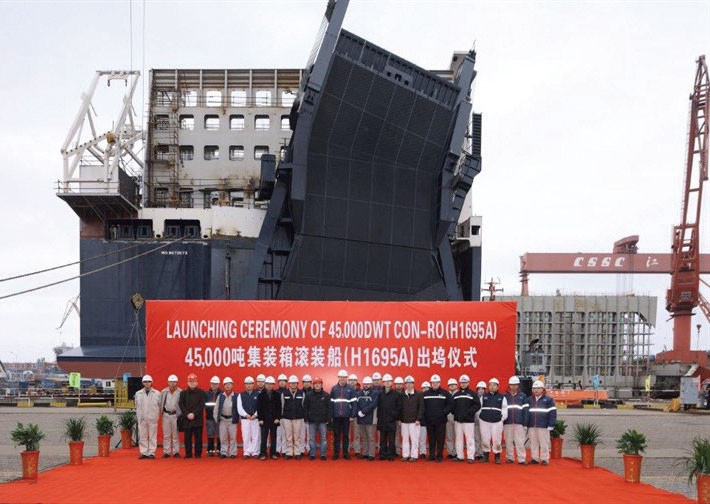The Ro-Ro (roll-on roll-off) design is inherently adaptable. But as Finn Wollesen, managing director for Knud E. Hansen explains in an interview with AJOT correspondent Matt Miller, there are many complexities to designing in the adaptability of a state-of-the-art Ro-Ro.
Shipbuilders and designers are giving the traditional roll on-roll off vessel a major makeover, adding function, flexibility and alternative power sources, as well as increasing the size and heft to the ships themselves. Hybrids in various shapes and sizes provide a growing alternative to the conventional Ro-Ro.

Denmark’s Knud E. Hansen A/S, one of the world’s premier naval architects, is a leading Ro-Ro designer and is in the forefront of a new generation of vessel design. In an interview, the company’s managing director, Finn Wollesen, talked to American Journal of Transportation about the future of new building, where adaptability is an operative word.
“There have been lots of discussions with end-users to optimize the vessels to their needs,” he said.
Examples of flexibility in function include combining Ro-Ros with container carriers, termed ConRos or RoCons; with passenger ferries, RoPax; and with reefer transport, Reefer Ro-Ros, (see story on page 3). With a growing emphasis on fuel economy and environmental considerations, hybrid propulsion is also gaining currency. That includes ships armed with batteries as well as LNG-powered engines, in addition to traditional bunker fuel.

Design Parameters
But Wollesen cautioned that designing multiple functions into a new vessel has a downside as well, if not sufficiently thought out. “You want to have a multi-useful vessel, many times you end up having a multi-useless vessel, because it will not be good for anything,” he said.
He cited as an example an operator that wanted to combine in a single vessel drilling for oil drilling, installing windmills and laying pipe. “It ends up being too expensive to operate in all three fields,” he said, adding, “It was never built, it was a bad idea.”
Environmental concerns drive many of the new decisions. “There are a lot of discussions, a lot of options to operate and save energy,” said Wollesen. “Look back ten years, everybody wanted to save energy, then the oil price went down, [but] a lot of owners still want to have a green profile and save energy.”
New ILO environmental regulations demand greater efficiency.
The Grimaldi Group is the latest to invest in new generation hybrid Ro-Ro vessels. In late April, the vessel owner and operator announced it had contracted with the Chinese shipyard Jinling to build six vessels, at a total investment of more than $400 million. Knud Hansen helped design the vessel.
The ships will employ fossil fuel while sailing, but rely solely on electricity while in port. The ships will utilize mega lithium batteries, equivalent the ship owner said, to 90 Tesla batteries, to power its systems at berth. The batteries will be charged during sailing in part through the use of solar panels.
According to Grimaldi, the new ship will consume the same amount of fuel as its current large vessel, but will handle double the loads, in effect also doubling efficiency. Ship delivery is expected in 2020.
Just this month, Wallenius Wilhelmsen Ocean took delivery on the first of four High Efficiency Ro-Ro vessels, dubbed HERO class. These 8,000 car equivalent capacity vessels cut down on energy consumption and emissions as well. They were designed with hoistable deck panels to provide flexibility in transporting breakbulk, rolling equipment and cars.

“We see that the global Ro-Ro capacity is becoming more balanced, and our focus is to make sure we have a flexible fleet, able to ramp up and scale down capacity in line with customer demand,” said Michael Hynekamp, president and COO. “As rates remain under pressure and CO2 regulation for shipping is evolving, we continue to monitor developments and assess our future capacity needs.”
Like Wallenius Wilhelmsen, an increasing number of other ship owners and operators want flexibility built into a new vessel, according to Wollesen. Preparation is key. Wollesen also gave the example of Ro-Ros that have hoistable decks. The deck is hoisted up when large and heavy lift cargo is being carried, and lowered when the vessel is transporting cars, allowing for an extra deck. Wollesen added that his firm is now looking at designs of Ro-Ro vessels that are built in such a way that an owner could put in a hoistable deck if wanted later. However, he declined to give details on the design or the client.
Ro-Ro and Containers?
Combining containers and Ro-Ro capabilities in one vessel offers a more complex picture. For a few years now, vessel operators have invested in this hybrid, with new and more radical designs, including higher decks and fewer columns. One of the most ambitious endeavors came from the Grimaldi subsidiary, ACL, which in 2015 launched its fourth generation ConRo vessel. These five ships were dubbed the largest ever ConRo vessels, boasting capacity to carry 3,800 TEUs and 1,300 car equivalent units. Instead of stowing containers on deck and lighter Ro-Ro cargo underneath, these new ships place Ro-Ro cargo midship, with containers in cells in front and behind. This results in cargo replacing ballast and more efficient use of space.

However, new regulations being put into place by the IMO called Energy Efficiency Design Index will make further construction of new ConRos “very difficult,” said Wollesen. That’s because a ship would have to meet both new Ro-Ro and container ship standards. “The rules basically work against each other,” said Wollensen. “Unless there’s a change on EEDI on combined vessels, I don’t see ConRos being built in near future.”
RoPax, by contrast, continue to gain in popularity. “It looks like this market is also picking up,” said Wollensen, who cited expected changes in the size of RoPax plying both the Baltic and Mediterranean seas, where these types of vessels have been traditionally popular.
But this type of combination is finding favor further afield, in places such as India and, especially, China, where they’re now being built.
“I’m curious to see what is coming in the next one or two years, now that building [these vessels] have started to move to China.
Knud Hansen provided the design for the first customized RoPax specifically for the Chinese market. This vessel was designed and built for travel in the extreme south of China, where sparsely populated – and politically disputed – islands are reliant on imported goods for just about everything. The vessel can carry vehicles, containers, trailers and passengers.




